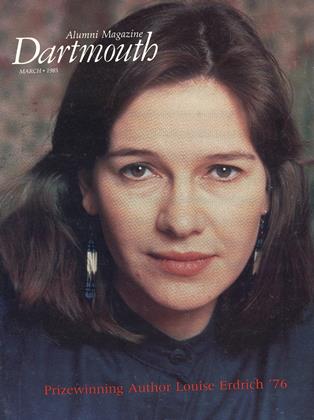There are treasures in the basement of Webster Hall, thousands of them. That is where sculptor Varujan Boghosian has his studio a large room, like a ballroom or a gymnasium, filled with the things he has collected over the past 20 years. The treasures cover the floors, the rows of tables, the walls, and the shelves, and some are tentatively arranged into one of his majestic, serene constructions.
Boghosian George Frederick Jewett Professor of Art, a member of the Department of Visual Studies at Dartmouth for the past 16 years, and a distinguished artist who has had over 15 oneperson shows in New York-was recently given yet another distinction. He has been named art chairman of the MacDowell Colony in Peterborough, N.H. He will collaborate with Edwin Cohen, head of General Atlantic, Inc., who was named the colony's business chairman. This is the first time that the chairmanship has been divided at the prestigious art colony, which has offered respite to, among others, more than 40 Pulitzer Prize-winners since it
began in 1907. Boghosian, with his dark, patrician face, friendly manner, and deep, vulnerable voice, is winning and likable. It is as easy to see him in his professorial role, where he'll continue to shape young artistic talent, as in his new one, where he'll shape the artistic purpose of the 77-year-old colony. "I think the MacDowell is a wonderful colony. . . . It's not a pleasure to be a part of it. It's awesome," said Boghosian, who has been a board member there for several years.
He is raring to go at the new job. He would like to double the colony's present endowment of $3.8 million to help maintain the facilities, expand the film program, and increase facilities in the studio arts. The colony offers tranquility during the day and a family-like atmosphere in the evening to writers, visual artists, composers, and filmmakers. Colonists stay an average of six weeks and are given large chunks of peace and quiet. They are brought a picnic lunch in their individual cabins and only gather together for breakfast and dinner in the main dining rooms.
Although never a colonist at MacDowell, Boghosian has found inspiration and material for his work at a more informal art colony, Provincetown, Mass. There, he combs the beaches in search of beautiful or interesting objects. "Once you find that something is around, then it is everywhere," said Boghosian of beachcombing. A tall pile of broken clay pipes is only one example of the kinds of things he has found on beaches.
All of his finds are imbued with the beautiful patina of age. Old wallpaper, old prints, drawings of figures and animals, architectural drawings, cards, children's clay blocks from Italy, old coins, games, ironing boards, wooden stretchers and boxes: the colors and textures of these things blend expertly in Boghosian's hands. "Boghosian's art is one of quiet, timeless perfection. His repertoire is narrow and familiar, but his art is constantly being refined, and consistently delights and haunts us," wrote art critic Stuart Greenspan in The WallStreet Journal about Boghosian's latest solo show at his New York gallery, Cordier and Ekstrom.
What is Boghosian's art about? It is about a myth. Boghosian is a man preoc- cupied with a myth that he plays and replays in countless variations, taking one part of it to express in one work, another part in another work. The myth is Orpheus and Eurydice, and Boghoian recounts it excitedly. It is a love story about the lyre player, Orpheus, and Eurydice, whom he loses, and the myth encompasses many different aspects of love. Boghosian portrays Orpheus in many different ways in his work: as a bird; as a skull, often seen from behind; as a butterfly. Eurydice is often'shown as a creche figure. It is the feeling behind the myth that Boghosian tries to express. At times his work is sentimental, at time tragic, at times mysterious.
For Boghosian, having a myth is essential for his art. "You have your myth, then you go out and try to find the material that fits that myth. Without the myth, the material is no good. Without the material, you can't bring out the myth."
He has spent most of a lifetime in search of the material to bring out his myth. He first was inspired by it during conversations with his Latin teacher in high school in New Britain, Conn., where he was born in 1926. At first he tried to write poems about it, and later he learned to illustrate it through constructions.
Before Boghosian turned to art, he was in the Navy. Then, thinking he might teach English, he went to Central Connecticut Teachers College under the G.I. Bill and then to Vesper George in Boston. He later earned his B.F.A. and M.F.A at Yale and studied painting in Italy on a Fulbright Grant.
Professor of Art Varujan Boghosian, recently named to cochair the MacDowell Colony, theprestigious art colony based in Peterborough, N.H., is flanked by two of his sculptures. Atleft is Orpheus and at right is Gray Day Study.
 View Full Issue
View Full Issue
More From This Issue
-
 Feature
FeatureIntimate Collaboration
March 1985 By Shelby Grantham -
 Feature
FeatureWHY STUDY EVOLUTION?
March 1985 By Warren D. Allmon '82 -
 Feature
Feature"I have Nineteen Thousand. Do I hear Twenty?"
March 1985 By Douglas Greenwood -
 Sports
SportsRecruiters' haul
March 1985 By Jim Kenyan -
 Article
ArticleDynamite
March 1985 By Alice Dragoon '86 -
 Article
ArticleRandom Thoughts
March 1985 By Gayle Gilman '85
Article
-
 Article
ArticleTIP TOP HOUSE ON MOUNT MOOSILAUKE
January 1921 -
 Article
ArticleRupert Brooke's Library
NOVEMBER 1931 -
 Article
ArticleChopping Champs
June 1980 -
 Article
ArticleMILESTONES
MAY 1930 By Craig Thorn, Jr. -
 Article
ArticleAfternoons With Frost
October 1973 By FIERMANJ. OBERMAYER '46 -
 Article
ArticleCOMMUNICATIONS
May 1921 By H. W. ROBINSON


